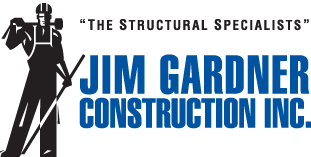One of the most frequent questions we get at Jim Gardner Construction is some variation of the following:
Why are there cracks in my house? Why are my floors not level? What should I do about it?
In this post we’ll break down typical causes and solutions for interior and exterior cracks so you can make an informed decision about how to take care of these issues the right way.
Common Causes of Cracks in Your Home
Cracks on the interior and exterior of your home, and floors out of level, are generally a symptom of structural issues down below. Since most people spend very little if any time in their crawlspaces, they are not seeing what are often some fairly obvious deficiencies that are causing these problems. The root cause of the problem most often occurs with drainage issues (this is especially true in our service area of Oakland, Berkeley, Piedmont, and Alameda CA). Inadequate surface and subterranean drainage systems cause water to travel under your foundations, and with older concrete with no rebar, they can develop cracks and shift or settle. At the exterior walls, this often occurs adjacent to downspouts that are not connected to any underground piping and are allowed to drain freely next to your house (not good).
When this happens, water can spread throughout the crawlspace, or when you are on a slope water will often pop up in the crawlspace after moving under the foundations and will cause dampness, mold and settlement in certain areas. Settlement can also occur at interior piers that are often shallow, or affect retaining walls on the downhill side of the crawlspace, causing moisture issues in finished or unfinished basements. Foundations will generally settle at the outside perimeter due to poor drainage, and this can cause floors to sink, sloping towards the outside. Sloping at points in the interior is generally caused by interior pier or central foundation settlement, and can sometimes be exaggerated by structural inadequacies created by work done in the crawlspace (generally framing that has been removed or modified to accommodate plumbing or heating ducts that has caused weaknesses at those locations).
Cracks on the interior usually occur around doors and windows, or at openings in walls that have a lot of weight being supported above them and are poorly supported below. These cracks often occur at the corners of these openings at the headers above doors and windows where the weight is concentrated.
How to Fix Cracks in Your Home
Proper drainage is key to preventing additional movement. If French drains and downspout drainage are inadequate or non-existent they should be installed ASAP. If the foundations are damaged or are in poor condition, they should be repaired or replaced. Improper framing should be repaired. Interior piers should be installed that are of proper dimensions to provide adequate support for the loads above. Once these corrections are made, any future settlement related problems should be minimal. Leveling can then be completed, though this is often not a simple process. The stucco has to be cut at the exterior and the floor lifted, and sometimes damage will occur to the interior or exterior in the areas being leveled, in relation to the degree of lifting required.
If the floor slope is substantial this may be a priority, but we minor sloping (generally figured at less than an inch per 10’) sometimes you can get away with leaving it alone. This is more of a cosmetic than a structural concern, so your tolerance for the unevenness has to be weighed against the complexity and cost of the leveling work. Sometimes it makes more sense to level the floors on the inside by adding various thicknesses of plywood and patching material and installing new flooring. This is easier in scenarios where floors are already scheduled for an upgrade.
Long story short, leveling, drainage and foundation and structural repairs should generally be done first before any substantial interior cosmetic work is done. Clients often have recurrent cracking on the interior that occurs seasonally and is difficult to deal with because it comes and goes. Once the drainage and structure are fixed then cracks will be much less likely to recur and interior cosmetic repairs should no longer need to be redone … saving you a lot of money in the long-run.



